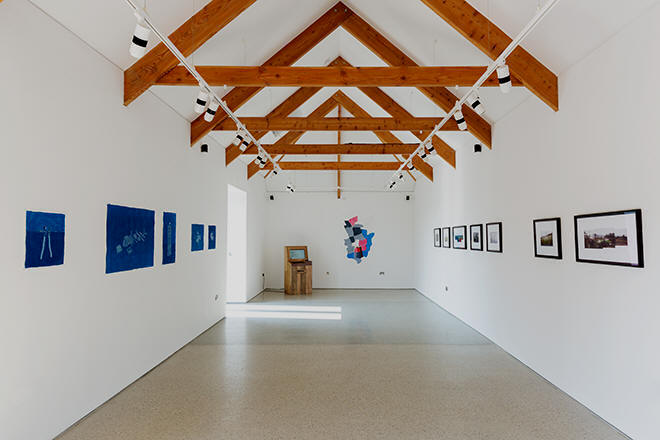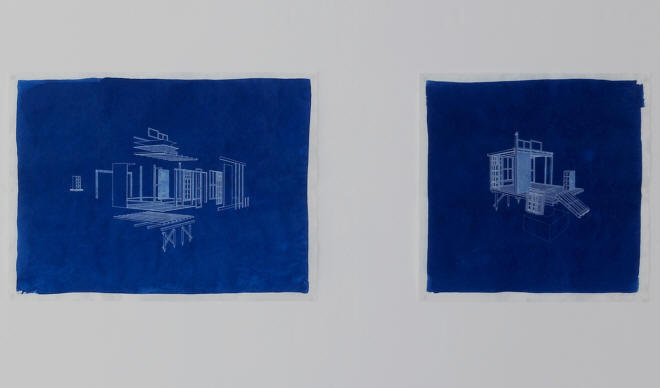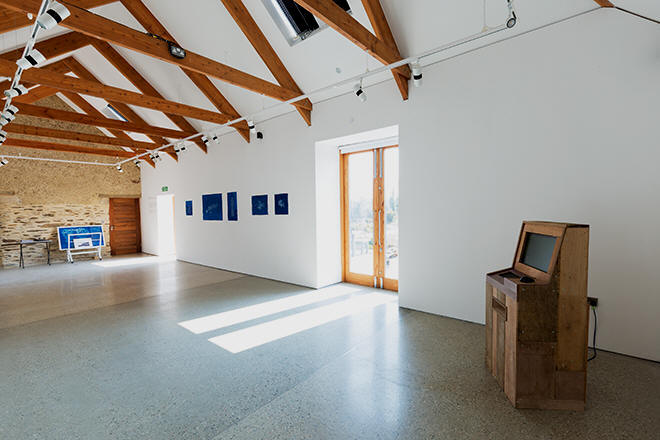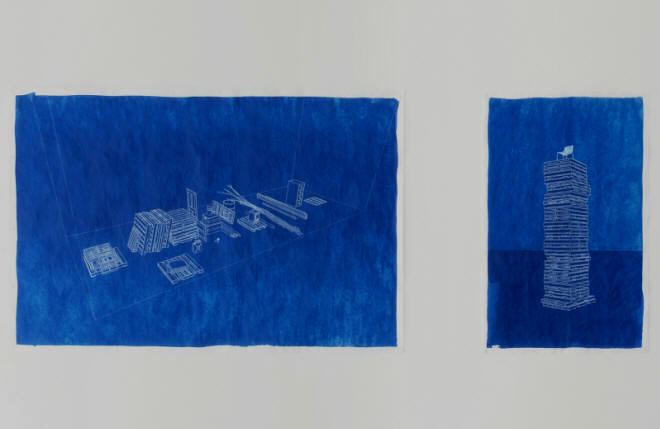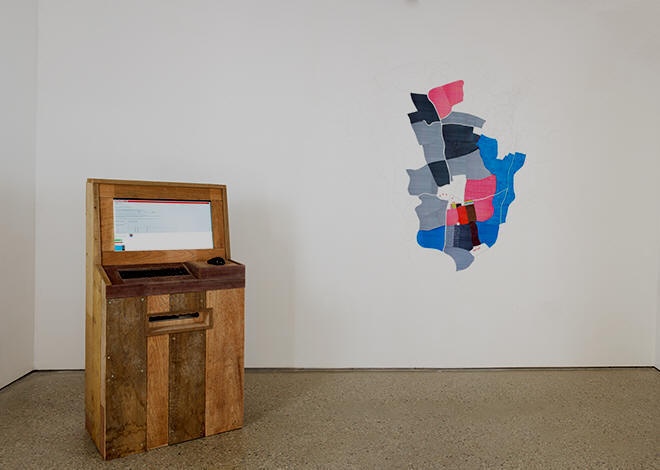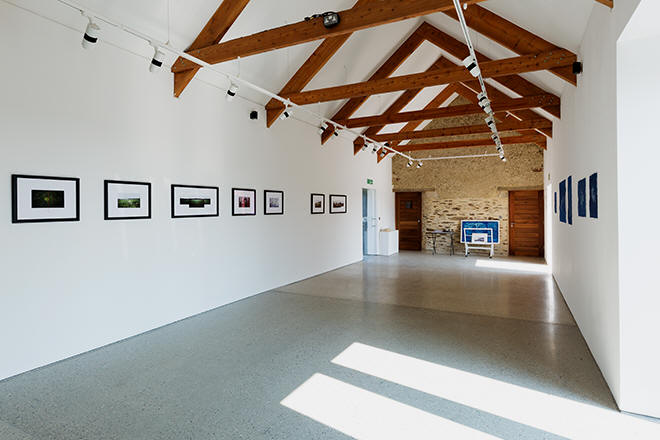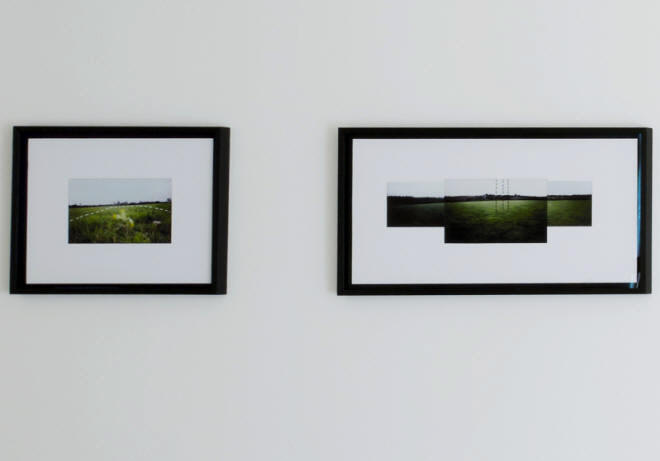|
|
| home | features | exhibitions | interviews | profiles | webprojects | archive |
|
Paul Chaney: Lizard Exit Plan – Kestle Barton Sector
For the past three years, artist Paul
Chaney has been creating drawings, texts, software and speculative
structures which outline how ‘to survive an unspecified apocalyptic
event, or just decouple from the economy of global capital’ on the
Lizard Peninsula. This manifestation of the Today a gallery with an artists’ residency programme, Kestle Barton is an ancient Cornish farmstead on the east of the Lizard just south of the Helford River. In the event of a disaster, the Lizard Exit Plan stipulates the site will be restored to its original function as an arable-dairy farm, with Chaney somewhat militaristically renaming it The Kestle Barton Sector in his survival scheme. Chaney’s ‘hypothetical reterritorialisation’ of the farm is rendered here in seven hand-printed silkscreens and five cyanotype blueprints for habitation. In Chaney’s art, the threat of apocalypse presents an irrevocable threshold which compels us to query our relationship to the land. In this scenario, the question raised is: what resources could the population of the Peninsula utilise if it had no choice but to live off-grid? Chaney’s art is a call for a reappraisal of manual skills and agrarian savvy made, it seems, obsolescent by industrialisation. It is also a salute to Ivan Illich’s tome Tools for Conviviality (1973). Illich characterised ‘conviviality’ as the ‘…autonomous and creative intercourse among persons and the intercourse of persons with their environment: and this is in contrast to the demands made upon them by others, and by a manmade environment.’ The philosopher postulated that technologies and institutions in modern society had usurped human independence and concurrently disrupted the equilibrium between man and the environment. As Chaney asserts ‘self-sufficiency is not about food but being skilled-up, about being autonomous.’ Accordingly, Chaney gives prominence in his art to the fencing plier, the primary tool employed in the construction of his pavilion Encampment Supreme (2015), built in compliance with what he terms ‘the apocalyptic vernacular’. In the blueprint Tool Horizon (2016), the horizontal line implicating a vista is subtly fractured, perhaps connoting society’s disconnect from practical and agricultural skills. Materials to construct a Potential Encampment (2016) are blueprinted in three prospects: the stockpile exhibited in all its potentiality (the plier pertinently central to the composition); as an exploded view characteristic of ‘how to’ manuals; and as a presentation drawing showing the constructed habitation. The ‘exploded’ view seems particularly charged as this work blasts the traditional bounds of site-specific work. Chaney’s ‘apocalyptic vernacular’ scheme to fabricate refuges for life is contingent on materials hyper-locally felled, procured or, even, looted. Therefore, the encampment conforms to a truly site-specific aesthetic. Accordingly, if it was to be realised elsewhere there would be a completely different repertoire of materials to hand, and thus Chaney’s structures would look markedly different. Post-apocalypta, the artist proposes The Kestle Barton Sector could sustain 28 human lives on the ‘Beef 4’ diet — a nutritional plan devised by Chaney utilising his software artwork the FieldMachine. The ‘Beef 4’ diet adheres to World Health Organisation standards, with the droll inclusion of planting provision to yield enough wheat and meat for an occasional pasty. Subsequently, Kestle Barton’s formal garden would be raked of its aesthetic in the name of utility: gauzy grasses and efflorescence duly culled to cultivate crops. Precisely rendered imprecise lines in Chaney’s scheme demarcate the ground-plan for the growth of vegetables, beans and soft fruit. His images of the site — captured in winter in an attempt to circumvent the verdant tradition which so often features in Landscape Art — are self-critical in their paradoxical attention to surface. Antagonistically, the laboriously rendered but blundering lines, as seen in Hypothetical Reterritorialisation – Formal Garden (2016), converge to reference forms found in the artworks of Peter Lanyon, Ben Nicholson and Barbara Hepworth — all British modernists with strong connections to Cornwall and an interest in abstracting the landscape in their art. In Chaney’s silkscreens, the lines trespass beyond the bounds of the images in a ludic spirit of anarchy. The prospect of anarchy is also raised by the artist’s invitation for visitors to operate FieldMachine in the gallery. Utilising data from the Department of Environment Food and Rural Affairs, the Organic Farm Management Handbook (Institute of Rural Studies, University of Wales) and the World Health Organisation, amongst others, Chaney’s device measures crop yield data against the nutritional content of the produce, calculating the area of land needed to provide the sustenance required for the community living on it. One can alter the artist’s recommended ‘Beef 4’ nutritional and fuel plan, determining how much of the population one would potentially have to sacrifice to survive. As such, the artist meditates on deontological (duty-based) ethics and Immanuel Kant’s ‘categorical imperative’; a moral rule expressed in The Groundwork of the Metaphysics of Morals (1785) proposing that one should only act in a manner that could be adopted as guiding principle for others, with an emphasis on good-will. The FieldMachine, then, is also a measure of a user’s benevolence or maleficence. The maps outputted by the FieldMachine are devoid of the colour green; a nod to the art of Mondrian who excised the colour from his palette as expression of his distrust of nature. Chaney’s eradication of the hue endorses this conviction, whilst eschewing the pop concept of ‘green living’: a rose-tinted view of self-sufficiency. Could you survive life in The Kestle Barton Sector?
words: Sarah Thacker, photos: Lucie Averill |
|
|

